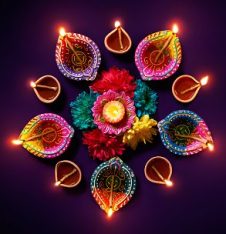
A quick Internet search for Diwali (pronounced dee-VAH-lee) yields many results that compare this Indian holiday to Christmas. While the bright colors and flowers associated with India’s most cherished festival may not immediately draw up images of a snowy Christmas, its emphasis on sweets, gift-giving, and spirituality will certainly resonate with you.
Introduction and Background
Though the exact reason for celebrating Diwali varies based upon region, Hindus generally recognize it as a celebration of the forces of light conquering forces of darkness. (For help pronouncing words in Hindi, click here.) According to National Geographic Kids, Hindus in northern India celebrate the story of King Rama’s return to Ayodhya after he defeated Ravana. In southern India, they celebrate Lord Krishna’s defeating the demon Narakasura, and in western India, Diwali honors the day that Lord Vishnu, the Preserver (one of the main gods of the Hindu trinity), sent the demon King Bali to rule the netherworld. To emphasize the symbolism of light versus dark, people light and place clay lamps (known as deepa) throughout their homes. In fact, Diwali comes from Sanskrit and means “row of lights.” Diwali is also a time for people to celebrate Lakshmi, the goddess of wealth.
Diwali is typically celebrated over the course of five days, and each day highlights different traditions, many of which are ripe with content for social/emotional, creative arts, and social studies learning. Begin your discussion of the holiday by reading Lots of Lights by Kavita G. Sahai or by sharing this National Geographic clip highlighting important aspects of the holiday.
A note about pronunciation: While a link for a translator has been included, it is important to remember that not all words will be available (some words are waiting for translation). Should you encounter a word while talking about the holiday or reading one of the books that you do not know how to pronounce, be honest with the children. Learning about other cultures is a process and one that can often be intimidating. Explain that you are learning together and that you are doing your best to give them accurate information.
Suggested Activities:
- Introduce or review opposites. The theme of light versus darkness creates an easy foundation for introducing and reviewing opposites. Explain to children that Diwali came to be because a King (or Lord) stood up to someone unkind. Ask children to recall any stories they know with a similar theme. Answers might include: Snow White and the Seven Dwarfs, Little Red Riding Hood, or Superman. Use a two-column graph and have children list the “kind” characters on one side and the “unkind” characters on the other. Describe kind and unkind as opposites. Extend this discussion by playing a movement game that focuses on opposite motions: walking forward, then backward, stretching up and down, reaching left, then right, crawling under and walking over, etc.
- Play with utensils. On the first day of Diwali it is custom to shop for new utensils (it is believed that this practice brings luck and wealth). During circle time, display utensils from your dramatic play area and talk about their uses. Consider bringing in a variety of utensils from home that may not be in your dramatic play area: a whisk, rubber spatula, tongs, a basting brush, or a mortar and pestle. Invite children to think about uses for these utensils. Play a guessing game during which you give children pretend cooking or eating scenarios and ask which utensil they might use. For example, you might say, “I want to mash an avocado to make guacamole. Which utensil should I use?” Answers might include mortar and pestle, whisk, or spoon.
- Clean up:
 People also believe that cleaning during the early days of Diwali can bring luck. Assign children different areas of the room to clean. A few children can be in charge of organizing or restocking the art area and others can hang or fold clothes in dramatic play. Challenge children to keep their assigned areas organized. Consider providing child-sized cleaning tools/supplies, such as spray bottles, washcloths, and brooms. Talk with children about personal items that are special to them and the ways that they take care of these things. Consider having a “show and tell” where children bring these items to school. Depending on the weather, you might want to have an outside cleanup day when the children rake leaves, tend to plants, or clean play equipment with soap and water.
People also believe that cleaning during the early days of Diwali can bring luck. Assign children different areas of the room to clean. A few children can be in charge of organizing or restocking the art area and others can hang or fold clothes in dramatic play. Challenge children to keep their assigned areas organized. Consider providing child-sized cleaning tools/supplies, such as spray bottles, washcloths, and brooms. Talk with children about personal items that are special to them and the ways that they take care of these things. Consider having a “show and tell” where children bring these items to school. Depending on the weather, you might want to have an outside cleanup day when the children rake leaves, tend to plants, or clean play equipment with soap and water.
- Explore color and light. On the second day of Diwali, it is custom for people to use colorful sand or powder to make designs called rangoli on their floors (see more pictures here).
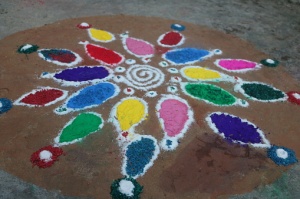 You can recreate this experience in your classroom by sectioning off part of a linoleum floor for the children to use or by taping down sheets of parchment paper if you do not want children to work directly on the floor. Children can also create designs on a table top or baking tray. You can help them get started by outlining a design with masking tape or permanent marker (depending on the surface) and encouraging them to color it in with colored sand or powder. Here are steps for making colored sand and colored powder if you are not able to purchase them. Continue to explore the concept of light and color by viewing color paddles, tissue paper, and Magna-Tiles on a light table. If you do not have a light table, consider making one. You can also cover a light table or projector with tracing paper and allow the children to draw with markers or test the transparency of different writing tools. Talk with children about the differences between transparency, translucency, and opacity. An object is transparent if light can pass through it and objects behind it can still be seen (examples include a window or a clear drinking glass). An object is translucent if it allows some light through, but objects behind it are blurry (examples include wax paper and tracing paper). Opaque objects—crayons, wooden doors, and pots and pans—do not allow any light to pass through.
You can recreate this experience in your classroom by sectioning off part of a linoleum floor for the children to use or by taping down sheets of parchment paper if you do not want children to work directly on the floor. Children can also create designs on a table top or baking tray. You can help them get started by outlining a design with masking tape or permanent marker (depending on the surface) and encouraging them to color it in with colored sand or powder. Here are steps for making colored sand and colored powder if you are not able to purchase them. Continue to explore the concept of light and color by viewing color paddles, tissue paper, and Magna-Tiles on a light table. If you do not have a light table, consider making one. You can also cover a light table or projector with tracing paper and allow the children to draw with markers or test the transparency of different writing tools. Talk with children about the differences between transparency, translucency, and opacity. An object is transparent if light can pass through it and objects behind it can still be seen (examples include a window or a clear drinking glass). An object is translucent if it allows some light through, but objects behind it are blurry (examples include wax paper and tracing paper). Opaque objects—crayons, wooden doors, and pots and pans—do not allow any light to pass through.
- Bake desserts. The third day of Diwali is about praying and eating. Here are 10 popular Diwali desserts, including kheer, Indian rice pudding, which you could make with children.
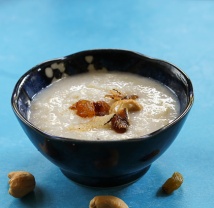 However, depending on where you live, some of the ingredients may be hard to find. If this is the case, ask children to name their favorite desserts and take a vote to choose one to make together. Invite family members and caregivers to enjoy this special treat, or ask them for recipe suggestions. As you eat, talk with children about what it means to be thankful.
However, depending on where you live, some of the ingredients may be hard to find. If this is the case, ask children to name their favorite desserts and take a vote to choose one to make together. Invite family members and caregivers to enjoy this special treat, or ask them for recipe suggestions. As you eat, talk with children about what it means to be thankful.
- Celebrate a new year. The fourth day of Diwali is considered the first day of the new year. Invite children to make a special card for a friend, relative, another classroom in your school, or a community organization with which you work closely.
- Talk about siblings or being an only child. On the last day of Diwali, siblings celebrate each other with gifts and by sharing a meal. Help children understand this by reading books about family, especially those that focus on siblings. Talk with children about how many siblings they have and graph the results. Ask them about things they like to do with their siblings or what traits they have in common.
Books about Diwali and India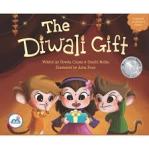
- The Diwali Gift by Shweta Chopra
- Good Night India by Nitya Khemka
- Lots of Lights by Kavita Sahai
- The Wheels on the Tuk Tuk by Kabir Sehgal & Surishtha Sehgal
- Diwali Lights by Rina Singh
- Diwali: A Cultural Adventure by Sana Sood
- Lighting a Lamp: A Diwali Story by Johnny Zucker
Books to support extension activities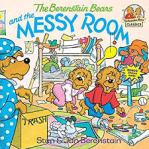
- The Berenstain Bears and the Messy Room by Stan & Jan Berenstain
- Big Bear, Little Chair by Lizi Boyd
- You Are (Not) Small by Anna Kang
- Peter’s Chair by Ezra Jack Keats
- The Family Book by Todd Parr
- Spoon by Amy Krouse Rosenthal
- Chopsticks by Amy Krouse Rosenthal
- Clean-Up Time by Elizabeth Verdict
Caution: When offering food, remember to seek parent/guardian permission and keep allergies in mind. Offer smaller bites or purees to infants and toddlers.
Back to blog listing